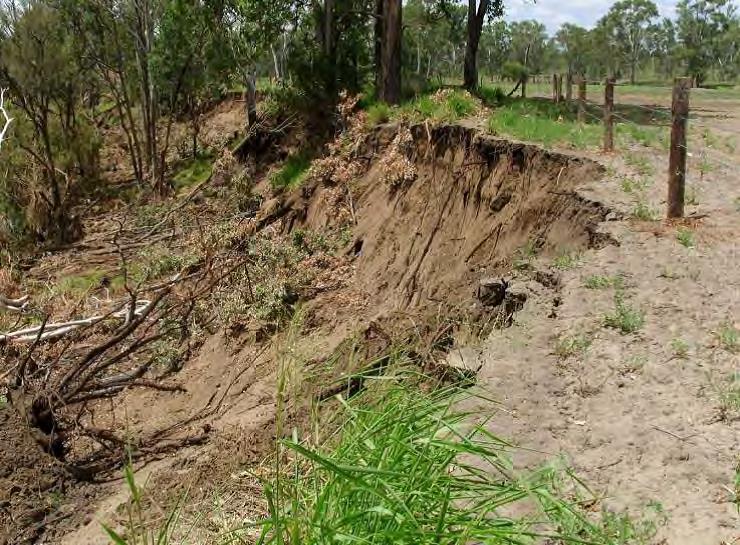The On-farm Productivity and Riparian Recovery Program was a disaster recovery package for flood impacted areas following Ex-Tropical Cyclone Oswald in early 2013 funded jointly by the Queensland and Australian Government.
The Burnett Mary Regional Group (BMRG) received $8M as part of the On-farm Productivity and Riparian Recovery Program to assist landholders to reinstate agricultural productivity and to become more resilient to future flood events.
BCCA will be assisting BMRG in the delivery of this Flood Recovery Program in the North Burnett Regional Council area.
There are 4 key areas to the program that BCCA will be delivering in the North Burnett Regional Council area:
- Riparian Stabilisation
- Floodplain Restoration
- Restoring Land Productivity
- Weed Control
1. Riparian Stabilisation
 The project aimed to provide cost effective and practical outcomes on rural lands that would benefit the rural community by:
The project aimed to provide cost effective and practical outcomes on rural lands that would benefit the rural community by:
- Enhancing riparian stability and resilience to reduce the risk of flood damage to the riparian natural assets and rural community infrastructure in the future;
- Supporting primary producers to accelerate recovery from flood impact by remediating severe riparian land degradation and restoring production values of agricultural land; and
- Providing priority technical on-ground support to control of bank scouring, bank slumping and gully erosion
.Riparian Stabilisation & Management program achieved, 13.4 km riparian stabilisation works, 119ha Improved riparian vegetation, Work for the Dole Program – Training, employment (40 volunteers), 2 Training events in Revegetation techniques provided to volunteers and staff, 3 Awareness raising events held, 33 landholder provided with technical Assistance and Inland Burnett revegetation and seed collection guidelines developed.
2. Floodplain Restoration
Floodplain Stabilisation & Management Technical assessments were undertaken to identify high risk floodplains requiring management. The Three Moon Creek Floodplain— from south of Cania NP to south of Mulgildie—was identified as a Priority Floodplain. Floodplain Management Plan for the Three Moon Creek floodplain prepared where landholders (primary producers, state & local government) worked together to develop the plan and implement the priority outcomes. There were a number of projects contracted across the floodplain, including erosion remediation, sand removal, permanent pasture establishment, creek crossings repairs and laser levelling. In addition a further two studies were undertaken to direct further on ground works, Hurdle Gully Hydraulic Flood Study and 170 hectare topographical survey.
The Floodplain Restoration program focused on stabilisation of flood damaged land and rehabilitation of soil fertility, coordination of flood overflow and drainage, reducing flood water concentration/diversion, and infrastructure placement.
The first stage of this program was for grants of up to $10,000 for farmers in the Three Moon Creek floodplain from Cania to just south of Mulgildie. Activities that were eligible include the following:
- Laser levelling
- Irrigation efficiency design
- Soil health (including soil testing and soil amendments)
- Removal of sand and gravel deposition from cultivation areas
- Professional agronomic advice
- Farm and financial planning
- On-farm infrastructure repair (i.e. roads, irrigation pumps, fencing)
- Scour repairs and erosion control on floodplains
The next stage of the program was the development of the Three Moon and Monal Creeks Floodplain Land Management Plan which was developed by Floodplain specialists Clive Knowles-Jackson, Geoff Titmarsh and John McClatchy from the Darling Downs. After consultation with Threemoon and Monal Floodplain landholders in December 2013, the Plan has been completed.
You can download a copy of the Three Moon & Monal Creeks Floodplain Land Management Plan here.
The next stage of the program was to start implementing priority actions from the plan.
3. Restoring Land Productivity
This program aims to provide farmers and graziers affected by the flooding events of ex-tropical cyclone Oswald in early 2013 with technical advice and support to aid in restoring land productivity. Such technical advice could include, but not limited to gully remediation advice, agronomic advice or irrigation repairing advice. This program is running until December 2014.
Increasing Land productivity in the Burnett Catchment provided Primary producers the opportunity to apply for a $10K grant within the Three Moon Creek floodplain to undertake restoration works such as repairing irrigation infrastructure, creek crossings, laser levelling, debris removal and fencing; 36 projects were contracted and completed under these grants.
BCCA has hosted two Irrigation Water and Energy Efficiency Workshops in Mundubbera and Monto during March 2014. Over 40 irrigators attended the two workshops. 24 flood-affected landholders who attended received a comprehensive, independent Irrigation Energy & Efficiency Assessment.
During April 2014, BCCA hosted Soil Health workshops in Monto and Mundubbera. Over 30 farmers attended the two days and from that 39 farmers were eligible to receive comprehensive soil testing on their flood affected properties. This Soil Health Fact Sheet was developed to assist landholders.
4. Weed control
BCCA coordinated the delivery of weed control activities in the North Burnett Regional Council area.
Landholders located along creeks and riverbanks and associated floodplains within the North Burnett Council boundary area were invited to participate in a program that would provide certain chemicals for weed control relating to flood recovery. The weed species include (click on the name for more information from Biosecurity Queensland):
- Parthenium weed (more info: http://bit.ly/19Tu8on)
- Giant Rats Tail grass (more info: here)
- Rubber Vine (more info: http://bit.ly/1aL3s5q)
- Hymenachne (more info: http://bit.ly/1a5sCfD)
- Cats Claw Creeper (more info: http://bit.ly/HiriMO)
- Madeira Vine (more info: http://bit.ly/HstaD0)
BCCA worked closely with the North Burnett Landcare Group and the North Burnett Regional Council to ensure a coordinated approach to weed control, also with an emphasis on the importance of groundcover management and good grazing land management.
Weeds-Post Flood Invasive Species Mitigation program provided herbicide direct to 103 landholders to use, 6 local suppliers were used for $75,000 on-ground weed control over two years. As a result 11,153ha weed control was completed.

